Scarborough Beach
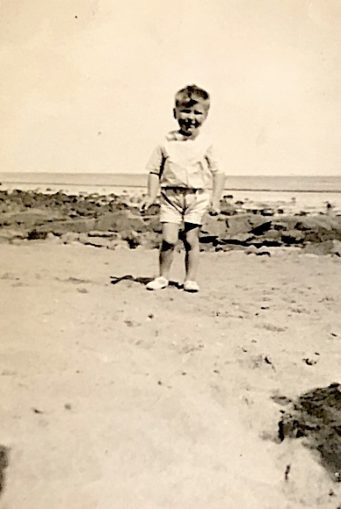
© Always Worth Saying 2023, Going Postal
Scarborough Beach is a renowned seaside destination known for its two sweeping sandy bays divided by the iconic Scarborough Castle. The North Bay offers a quieter ambience, while the South Bay is livelier, hosting an arcade, fairground attractions, shops, and eateries. The beach is also home to the famous Scarborough Spa, a venue for conferences and entertainment events. It’s a perfect spot for a family day out, offering activities like surfing, donkey rides and rock pooling. Lifeguards patrol Scarborough Beach during the summer and has full wheelchair access. However, dog restrictions are in place on certain parts of the beach between May and September. It is advised to check the local council’s website for the most current information.
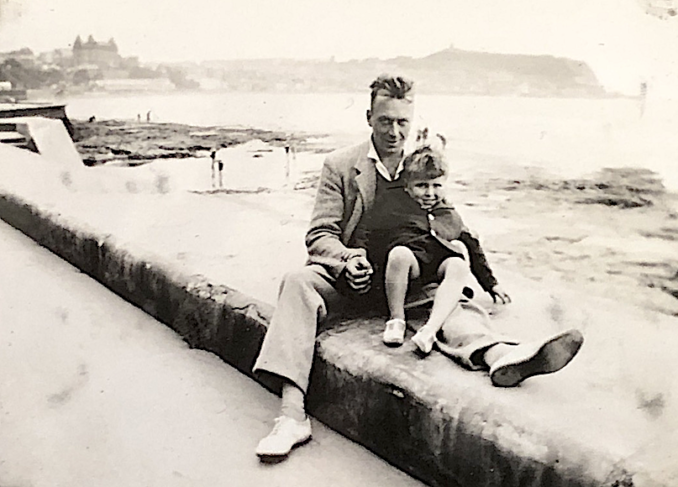
© Always Worth Saying 2023, Going Postal
Although picture one could be anywhere, picture two gives away a precise location. Notice the concrete wall and the steps down to the beach to the left. Above that we see the distinctive outline of the Grand Hotel and far to the right of that the headland that divides the North and South Bay with Scarborough Castle on the top and to the left of the 19-acre headland. In the modern day via the miracle of Street View, we can find the same spot.
There are the concrete steps to the left. Railings have been added to the top of the sea wall. The shore looks much rockier but reference to old and new photos show that the sands shift with the tides and weather.
Out of sight in the old photo is a hideous building built above the promenade before which site is the entrance to the Scarborough Spa Cliff Lift. You can have a look around here.
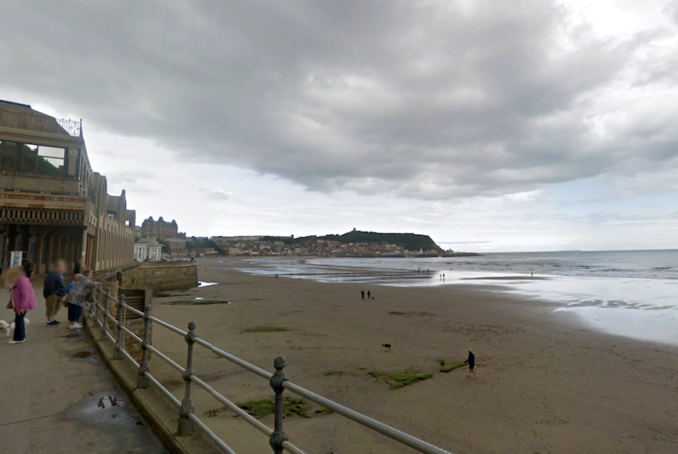
© Google Street View 2023, Google.com
To the left is a boarded-up building. Behind and to the right, a crescent of beach huts sits below the Clock Cafe. I suspect in the summer of 1936 my father and his parents walked from the war memorial on Oliver’s Mount (featured here a couple of episodes ago) through the gardens to the Clock Cafe or descended to the seafront via the Scarborough Spa Cliff Lift which sits in the other direction, just beyond the boarded up building.
Scarborough’s Spa and Cliff Lifts
The Scarborough Spa Cliff Lift, also known as the South Cliff Lift, was completed in 1875 at a cost of around £8,000. It was the project of the Scarborough South Cliff Tramway Company, established in 1873, to link the South Cliff Esplanade to the Scarborough Spa. The lift was engineered by William Lucas and constructed by the Crossley Brothers, while the cars were supplied by the Metropolitan Railway Company.
The original hydraulic operating system of the lift was later replaced by coke-burning steam pumps, and in 1934-35, (just before my grandparents’ and father’s visit) the lift underwent a refurbishment, receiving new cars and an electric winding motor. It was originally officially opened on July 6, 1875, and was the first funicular railway in Great Britain.
The lift’s popularity fluctuated over the years, notably decreasing after a fire at the Spa Saloon but picking up again after its reconstruction. By 1945-46, it was ferrying 1.2 million passengers per year. The Scarborough Borough Council bought the lift in 1993 and made it automatic in 1997. It last underwent maintenance and repairs in 2007.
Tragedy struck in 1925. In the last episode, we mocked an ugly concrete footbridge replacing a foot crossing on the Scarborough Bay 20-inch gauge leisure railway. However, the health and safety wallahs might have a point. The 21st April 1925 edition of the Leeds Mercury reported an inquest had opened and adjourned at Scarborough regarding the death of Mr Athrur Fletcher, a 59-year-old retired postal worker who had been struck by the ‘up’ car of the Scarborough South Cliff lift when oiling the track.
The Scarborough Spa itself boasts a rich history that traces back to the early 17th century when natural mineral waters were discovered in the area. This discovery spurred the growth of tourism in the town, leading to the construction of a spa house in the early 1700s, solidifying Scarborough’s reputation as England’s first true seaside resort.
Unfortunately, this original spa house was destroyed in a storm in 1735, necessitating the construction of a new building in 1739. Over the years, this building underwent multiple damages and was eventually replaced in the 1820s by a new structure, complete with a concert hall, gardens, and a promenade.
Further improvements were made when the spa was redesigned by Sir Joseph Paxton and reopened in 1858. Scarborough Spa continued to be a popular seaside resort, attracting music hall stars and establishing itself as an entertainment hub. Although the public consumption of the mineral waters ceased in the 1960s, the spa complex underwent alterations to meet changing demands.
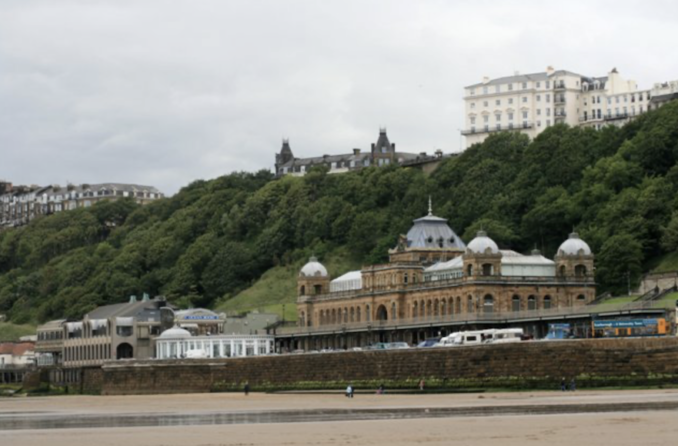
Scarborough Spa Complex,
Mike Garratt – Licence CC BY-SA 2.0
Today, Scarborough Spa comprises the Spa Theatre, the Grand Hall, the Ocean Room, and various other facilities, standing as a testament to the town’s history and significance as a seaside resort. A much grander cliff lift sits at the other end of the South Bay appropriately beside the Grand Hotel.
The Scarborough Central Tramway, also known as the Central Cliff Lift, is the oldest surviving tramway company in the UK. It was built in 1881, inspired by the success of the South Cliff Tramway Company, and operates an electric-powered funicular railway. The railway, which boasts distinctive burgundy and cream carriages, travels between a bottom station on Foreshore Road and a top station on Marine Parade.
John Woodall Woodall, a successful businessman, was the first Chairman of the company. The construction of the Central Tramway was completed by George Wood as the contractor, Charles Augustus Bury as the architect, and Thomas Feaster Morgan as the chief engineer. On its opening day, almost 3,000 passengers travelled on the tramway. The original mode of propulsion was steam power, but it later switched to electric power. The Central Tramway Company Cliff Lift Scarborough celebrated its 140th anniversary in 2021.
Tragedy struck there too. In 1934, a Mr Ricard K Coupe, a fitter of All Saints Road, Scarborough, was severely injured when he fell several feet from the platform of the lower station of the Scarborough Central Cliff Lift while on repair work.
Talk of which leads to its next-door neighbour, the impressive building to the right, the Grand Hotel.
Grand Hotel Scarborough
The Grand Hotel, located in the town centre, is an iconic Victorian building that overlooks the picturesque harbour and South Bay. This historic hotel, designed by Cuthbert Brodrick, opened its doors in 1867 and is a Grade II-listed building. The hotel’s architectural design is in the Callender house style, incorporating the elements of time with four towers representing the seasons and 12 floors representing the months of the year. It initially housed 365 bedrooms, symbolizing each day of the year.
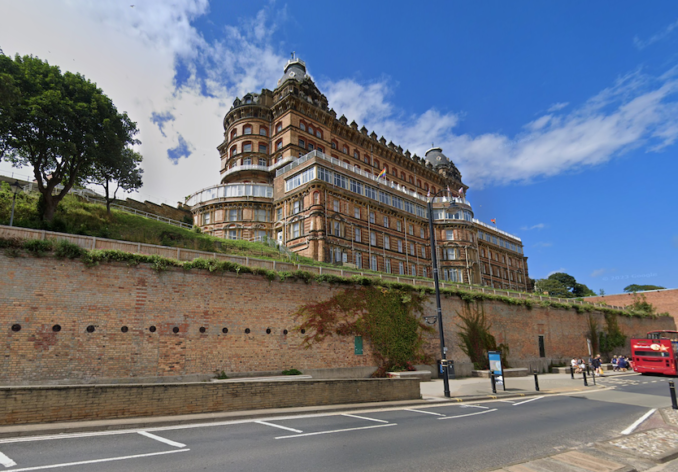
© Google Street View 2023, Google.com
The hotel offers several amenities, such as two restaurants, a coffee shop, and two bars. It hosts live entertainment every night in the ballroom. The hotel also provides rooms without windows and caters to events like baby showers and gender reveal parties.
The Grand Hotel Scarborough has a rich history. It was damaged during a German Navy raid in 1914 and later served as a home for RAF trainees during World War II. It was purchased by Butlins in 1978 and then by the notorious Britannia Hotels in 2004. Despite its grandeur, the hotel has faced several health and safety issues in recent years.
Recently, the hotel has been serving as temporary housing for hundreds of Afghan immigrants. Operation Warm Welcome, however, met with mixed reactions. Some British guests expressed dissatisfaction, leaving negative reviews online about disturbances caused by ‘uncontrolled refugee children’. Some even requested refunds. The Afghans thought little better, with the Sun newspaper reporting some ‘so distraught that they want to return home,’ between its own reporter’s tales of sewage in his bath and buckets in the corridor to catch drips from the ceiling.
In addition, the decision to house these refugees has led to the distribution of anti-immigration leaflets around the hotel and a bomb hoax. Local officials unsurprisingly condemned these incidents, deeming them racially motivated attempts to undermine the housing of the Afghans. Am I the only Puffin who suspects that much of what was seen and heard by Afghans ‘working with British forces in their homeland’ found its way to the Taliban?
And on that cheery note, happy Christmas.
© Always Worth Saying 2023



